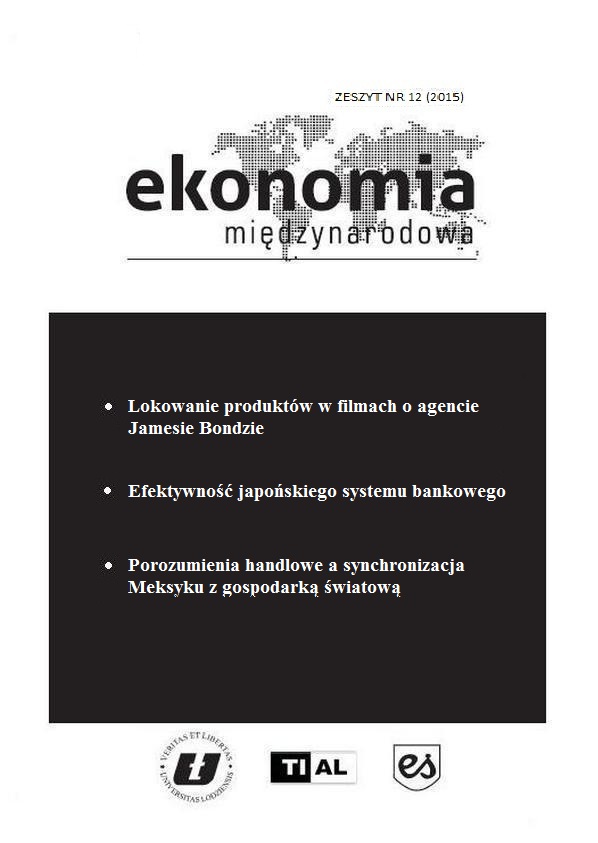Wpływ porozumień handlowych na synchronizację gospodarki meksykańskiej z gospodarką światową
DOI:
https://doi.org/10.18778/2082-4440.12.01Słowa kluczowe:
porozumienia handlowe, synchronizacja cykli koniunkturalnych, analiza odpowiedzi na impulsAbstrakt
W artykule omówiono porozumienia handlowe zawarte między Meksykiem a innymi krajami. Wyniki analizy odpowiedzi na impuls oraz współczynników natychmiastowej quasi-korelacji wskazują na znaczący wzrost synchronizacji meksykańskiego cyklu koniunkturalnego z cyklami krajów rozwiniętych oraz
na istotny wzrost wrażliwości gospodarki meksykańskiej na szoki w gospodarce światowej.
Bibliografia
Abiad A., Furceri D., Kalemli-Ozcan S., Pescatori A. (2013), Dancing Together? Spillovers, Common Shocks and The Role of Financial and Trade Linkages [w:] World Economic Outlook (Washington: International Monetary Fund, October), s. 81–111.
Google Scholar
Artis M., Chouliarakis G., Harischandra P.K.G. (2009), Business Cycle Synchronization since 1880, Paper presented at the International Symposium on Business Cycle Behaviour in Historical Perspective, University of Manchester, June 2009.
Google Scholar
Czerewasz, K. (2003), Procesy integracyjne w Ameryce Północnej, Wydawnictwo Politechniki Białostockiej.
Google Scholar
Dees S., Zorell N. (2011) Business cycle synchronization. Disentangling trade and financial linkages, ECB Working Paper, No. 1322.
Google Scholar
DOI: https://doi.org/10.2139/ssrn.1793864
General Agreement on Tariffs and Trade (1994).
Google Scholar
Gwiazda A. (1998), Globalizacja i regionalizacja gospodarki światowej, Wydawnictwo Adam Marszałek, Toruń.
Google Scholar
Imbs J. (2006) The real effects of financial integration, Journal of International Economics, nr 68, s. 296–324.
Google Scholar
DOI: https://doi.org/10.1016/j.jinteco.2005.05.003
Latoszek E., Proczek M. (2006), Organizacje międzynarodowe we współczesnym świecie, Dom Wydawniczy Elipsa, Warszawa.
Google Scholar
Liberska B. (1991), Strategia rozwiązywania kryzysu zadłużenia w Ameryce Łacińskiej, Uniwersytet Jagielloński, Kraków.
Google Scholar
Lutkepohl H. (1993), Introduction to Multiple Time Series Analysis, Springer-Verlag.
Google Scholar
DOI: https://doi.org/10.1007/978-3-642-61695-2
North American Free Trade Agreement Legal Text (1994).
Google Scholar
Rymarczyk J., Wróblewski M. (2006), Pozaeuropejskie ugrupowania integracyjne, Wydawnictwo Arboretum, Wrocław.
Google Scholar
Staszewska-Bystrova A. (2009), Wektorowe modele autoregresyjne w analizie makroekonomicznych szeregów czasowych, Towarzystwo Naukowe Organizacji i Kierownictwa „Dom Organizatora”, Toruń.
Google Scholar
Śledziewska K. (2012), Znaczenie trzeciej fali regionalizmu w regulowaniu współpracy międzynarodowej, Studia Ekonomiczne – Zeszyty Naukowe, Uniwersytet Ekonomiczny w Katowicach, zeszyt nr 123, Katowice 2012.
Google Scholar
Tchorek G. (2010), Teoretyczne podstawy integracji walutowej [w:] Kowalewski P., Tchorek G. (red.), Mechanizmy funkcjonowania strefy euro, Wydawnictwo NBP, Warszawa.
Google Scholar
The General Agreement on Tariffs and Trade (1947).
Google Scholar
Villarreal M.A. (2012), Mexico’s Free Trade Agreements, Congressional Research Service.
Google Scholar
Welfe A. (2009), Ekonometria. Metody i ich zastosowanie, Polskie Wydawnictwo Ekonomiczne, Warszawa.
Google Scholar
WTO Legal Text, Differential and more favourable treatment reciprocity and fuller participation of developing countries, Decision of 28 November 1979 (L/4903).
Google Scholar
WTO Legal Text, Uruguay Round Agreement (1986).
Google Scholar
Pobrania
Opublikowane
Jak cytować
Numer
Dział
Licencja

Utwór dostępny jest na licencji Creative Commons Uznanie autorstwa – Użycie niekomercyjne – Bez utworów zależnych 4.0 Międzynarodowe.









